CRM or Customer Relationship Software is no longer a key phrase. Today, over 65% of business owners rely on CRM software for the success of their operations.
While using a CRM is a great idea to improve your business and revenue, how often do you think about the effectiveness of your software?
Your CRM software development company may have customized features per your business. But is the software bringing you the desired results?
In this article, we take a closer look at some key metrics that help you understand the effectiveness of your CRM. Continue reading as we learn more about it in the following sections of the blog.
Key Factors That Measure The Effectiveness Of Your CRM
Rate Of Renewal
This CRM indicator is critical for subscription-based organizations since it records how often consumers renew their engagement with your firm (i.e., continue using your product or service).
The renewal rate is a crucial measure of company performance and development, and it simply tells you if your firm provides long-term value to its clients. It is also an elementary statistic for measuring CRM. For instance, if your company has 100 clients at the beginning of the year and only 95 renew their contracts, your renewal rate stands at 95%.
Close Rates
Close rates (closing ratios) – the holy grail of sales analytics – is another wonderful approach to analyzing CRM success. A closure rate is the number of concluded transactions divided by the number of leads in the pipeline. If you have 100 leads but only close 15, your close rate is 15%.
However, while you’re at it, remember that while close rates are an excellent performance indicator, they do not necessarily provide a whole picture. It all boils down to your specific business and typical deal size. However, if your CRM is successful, your close rate will automatically rise.
Customer Retention
Customer turnover, customer churn, or customer attrition is the inverse of your retention rate and tells you how many customers you lose over a specific time, such as monthly, quarterly, or yearly. If the retention rate rises, the turnover rate must fall.
This is a simple and beneficial indicator to monitor for your small business since it may help you understand why customers are departing and the strategy of how to maintain them.
To calculate your customer retention, divide the number of lost clients by the total number of customers to determine the turnover rate.
Net Promoter Score
How likely are your consumers to promote your company to others? A Net Promoter Score (NPS) is a customer success indicator that evaluates customer loyalty on a scale of 1 to 10.
To calculate NPS, survey customers with questions like “On a scale of 0 to 10, how likely will you (customer) recommend our service to a friend or colleague, and why did you choose that score?”
‘Promoters’ have a score of 9-10 and are pleased with what your company has done for them. With a score of 7-8, ‘passives’ are individuals who get what they want from your company but aren’t overly enthused about it. ‘Detractors’ have a lower score of 0-6 and have had a less-than-satisfactory experience, making them more inclined to transfer to a rival.
Average Number Of Follow-Ups Per Issue
You should also consider how many calls or emails are required to fix the average issue. Instead of measuring how soon a customer or representative responds (as the average time to resolution statistic does), this metric analyzes the effectiveness of different responses.
CRM lowers this measure by providing clients with the most relevant and targeted information the first time. All in one CRM software lets you see everything about your client in one location, including behavior, preferences, activity, and past support issues.
Takeaway For An Effective CRM Strategy
While these were some key indicators to determine the success of your CRM, they’re only as successful as your CRM strategy.
A CRM strategy keeps your firm focused on its objectives. As previously said, a CRM comprises several essential tools and functions. However, just because they are available does not imply they should be used immediately.
Here are some takeaways to help you streamline your operations via an effective CRM strategy:
Understand Your Goals
Every business wants to improve customer relationship management but misses the crucial question: How?
So, while you’re at it, ensure that you target specific client behaviors and interactions throughout your operations. Moreover, note them since they will influence how you design your CRM settings and reports.
Define Your Ideal Customers
Next, you must define your ideal customers. Every business has a specific set of customers it caters to. Therefore, ensure that you define your ideal customer(s) and categorize them as buyer personas.
This information is useful for marketing and sales but also beneficial for you to determine which sorts of clients should be included in your CRM in the future – and which should not.
Map Your Customer Journey
How do your customers usually “meet” your company? How many touchpoints do consumers require on average before subscribing to your email, becoming a customer, and returning for more?
This customer journey will alter as your client base increases and buyer personas are segmented into more comprehensive profiles.
Conclusion
Running a successful business is more than your CRM. It requires you to focus on all aspects of your operations. However, when done right, customer relationship software can help streamline most of your operations. Therefore, connect with the right software development company and pick up on strategies that work best for your business. All the best!



